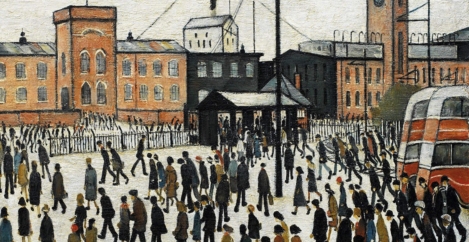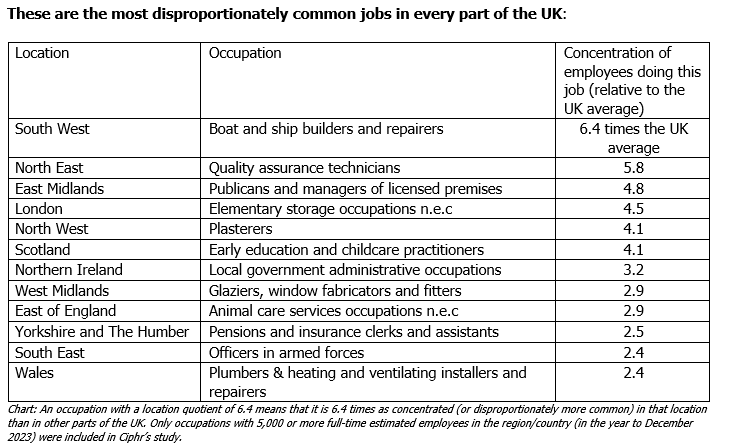June 12, 2024
Britain is no longer a nation of shopkeepers, but it is divided by the work we do
 Following last week’s news that the fastest growing job category in the US isn’t necessarily the one you’d expect, a new report from HR software provider Ciphr, based on ONS data, claims to identify which jobs are the most disproportionately common in each part of the UK. The report analyses the latest regional employee estimates for over 370 occupations to find out which work roles (with at least 5,000 full-time employees) appear to be more concentrated, or over-represented, in some places more than others.
Following last week’s news that the fastest growing job category in the US isn’t necessarily the one you’d expect, a new report from HR software provider Ciphr, based on ONS data, claims to identify which jobs are the most disproportionately common in each part of the UK. The report analyses the latest regional employee estimates for over 370 occupations to find out which work roles (with at least 5,000 full-time employees) appear to be more concentrated, or over-represented, in some places more than others.
The study didn’t focus on the jobs with the most employees in each area. Instead, it looked at the jobs being done by a disproportionately higher share of people in each area, compared to the UK average (using location quotient analysis). For example, it may not be surprising to learn that there is nearly twice the concentration of CEOs in London than elsewhere.
Nationwide, around 39 out of every 10,000 employees are CEOs (and senior officials). That’s 0.39 percent of the estimated 21.6 million full-time employees in the UK. But in London, that figure (or employment share) nearly doubles to 76 CEOs for every 10,000 employees (or 0.76 percent). This means that CEOs are 1.9 times more proportionately common in London compared to the rest of the UK.
Wales has the lowest concentration of CEOs – employing CEOs at 0.3 times the national rate – with just 14 CEOs out of every 10,000 employees.
The ratio of CEOs to employees in each part of the UK:
- London: 76 per 10,000 employees
- East of England: 61
- South East: 48
- East Midlands: 43
- South West: 38
- Northern Ireland: 37
- Yorkshire and the Humber: 35
- North East: 20
- Scotland: 19
- North West: 17
- West Midlands: 15
- Wales: 14
Here are the highlights from the report’s findings for each part of the UK:
London
London has the UK’s highest concentration of people employed in elementary storage occupations n.e.c (including order pickers and warehouse operators). Around 28 out of every 10,000 employees do this job here, over four times the UK average. The region also has around three times the national average of actuaries, economists and statisticians, solicitors and lawyers, interior designers, authors, writers and translators, and brokers, compared to the rest of the country.
South East
Officers in the armed forces is the most disproportionately common occupation in the South East. Around 35 out of every 10,000 employees in this region are employed in this role, over twice the UK average. Other popular occupations here (at double the UK average) include biological scientists, computer system and equipment installers and servicers, medical secretaries, and train and tram drivers.
East of England
The East of England has a greater share – nearly three times the UK average – of people employed full-time in animal care services occupations n.e.c (including animal welfare officers, zookeepers and vet assistants). Around 35 per 10,000 employees here work in these jobs, compared to 12 per 10,000 employees across the rest of the UK. There’s also a high concentration (at least twice the UK average) of newspaper and periodical editors, managers in transport and distribution, production and process engineers, and events managers and organisers.
East Midlands
The East Midlands has the highest concentration of publicans and managers of licensed premises, at nearly five times the UK average (46 per 10,000 employees vs 10 per 10,000 employees elsewhere). People in this region are also disproportionately more likely to be employed as managers and proprietors in agriculture and horticulture (4.7 times more likely than the UK average), skilled metal, electrical and electronic trades supervisors (three times more likely), and large goods vehicle drivers (twice more likely).
Yorkshire and the Humber
Yorkshire and the Humber is home to a higher than average share of pensions and insurance clerks and assistants. Around 63 of every 10,000 employees in this region are employed in this job – 2.5 times the UK average. There are also twice as many (relative to the rest of the UK) mental health nurses, and child and early years officers.
North East
People who work in the north-east of England appear disproportionately more likely to be employed as quality assurance technicians than in other parts of the country. Around 68 per 10,000 employees are employed in this role – nearly six times the UK average. The region also has a high share (around three times the UK average) of employees in the welding trades, elementary construction occupations n.e.c, and call and contact centre occupations.
Scotland
Scotland has the UK’s highest concentration of early education and childcare practitioners, at four times the national average (or 85 per 10,000 employees). It also has a higher-than-average proportion of people employed as painters and decorators (over three times the UK average). And twice as many (relative to the rest of the UK) IT quality and testing professionals, bank and post office clerks, architects, and officers of non-governmental organisations (NGOs).
Northern Ireland
Northern Ireland is home to a disproportionately high share of employees working in local and national government administrative occupations. 151 and 183 out of every 10,000 employees in this region are employed in these occupational groups respectively (3.2 and 2.5 times the UK average). There’s also over twice the number of teaching assistants, postal workers, mail sorters and messengers, and other nursing professionals (including nurses, sisters and matrons) per 10,000 employees.
North West
There are over four times as many plasterers in the north-west of England than anywhere else in the UK. Around 23 out of 10,000 employees in this region work in this role (the average is 6 per 10,000 for the rest of the country). Other jobs that are also more disproportionately popular here include electrical and electronics technicians (three times the UK average), careers advisers and vocational guidance specialists, and cybersecurity professionals.
West Midlands
The West Midlands employs glaziers, window fabricators and fitters at nearly three times the national rate (29 per 10,000 employees vs 10 per 10,000 employees). The region also has higher-than-average employment shares (over double the UK average) of metal working machine operatives, early education and childcare services managers, credit controllers, forklift truck drivers, and electrical engineers.
Wales
Wales has over twice as many plumbers and heating and ventilating installers and repairers as other parts of the UK, with 92 per 10,000 employees (although the North East has the greater number). Educational support assistants and health and safety managers and officers are also nearly twice as prevalent here.
South West
The south-west of England has a significant cluster of boat and shipbuilders and repairers in work. According to the latest ONS data, 30 of every 10,000 employees in this region do this job role – that’s over six times the UK average. The region also has higher concentrations (over double the UK average) of farm workers, non-commissioned officers and other ranks, carpenters and joiners, and aerospace engineers.
Ciphr also conducted research into the occupations with the largest workforces to discover the top 20 most common jobs in the UK. The occupational group with the most full-time employees is programmers and software development professionals, followed by care workers and home carers. The top five also includes other administrative occupations n.e.c (office administrators and clerical/admin assistants), secondary education teaching professionals, and financial managers and directors.
Image: From Going to Work by L S Lowry. Public domain















